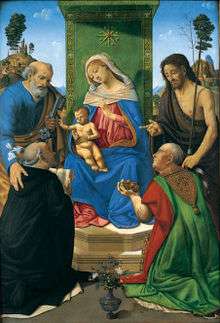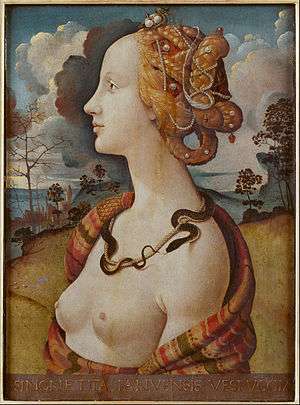Piero di Cosimo



Piero di Cosimo (2 January 1462[1] – 12 April 1522), also known as Piero di Lorenzo, was a Florentine painter of the Italian Renaissance.
He is most famous for the mythological and allegorical subjects he painted in the late Quattrocento; he is said to have abandoned these to return to religious subjects under the influence of Savonarola, the preacher who exercised a huge sway in Florence in the 1490s, and had a similar effect on Botticelli. The High Renaissance style of the new century had little influence on him, and he retained the straightforward realism of his figures, which combines with an often whimsical treatment of his subjects to create the distinctive mood of his works. Vasari has many stories of his eccentricity, and the mythological subjects have an individual and quirky fascination.[2]
He trained under Cosimo Roselli, whose daughter he married, and assisted him in his Sistine Chapel frescos. He was also influenced by Early Netherlandish painting, and busy landscapes feature in many works, often forests seen close at hand. Several of his most striking secular works are in the long "landscape" format used for paintings inset into cassone wedding chests or spalliera headboards or panelling. He was apparently famous for designing the temporary decorations for Carnival and other festivities.
Biography
The son of a goldsmith, Lorenzo di Piero, Piero was born in Florence and apprenticed under the artist Cosimo Rosseli, from whom he derived his popular name and whom he assisted in the painting of the Sistine Chapel in 1481.
In the first phase of his career, Piero was influenced by the Netherlandish naturalism of Hugo van der Goes, whose Portinari Triptych (now at the Uffizi Gallery in Florence) helped to lead the whole of Florentine painting into new channels. From him, most probably, Cosimo acquired the love of landscape and the intimate knowledge of the growth of flowers and of animal life. The manner of Hugo van der Goes is especially apparent in the Adoration of the Shepherds, at the Berlin Museum.
He journeyed to Rome in 1482 with his master, Rosselli. He proved himself a true child of the Renaissance by depicting subjects of Classical mythology in such pictures as the Venus, Mars, and Cupid, The Death of Procris, the Perseus and Andromeda series, at the Uffizi, and many others. Inspired to the Vitruvius' account of the evolution of man, Piero's mythical compositions show the bizarre presence of hybrid forms of men and animals, or the man learning to use fire and tools. The multitudes of nudes in these works shows the influence of Luca Signorelli on Piero's art.
During his lifetime, Piero acquired a reputation for eccentricity—a reputation enhanced and exaggerated by later commentators such as Giorgio Vasari, who included a biography of Piero di Cosimo in his Lives of the Artists.[3] Reportedly, he was frightened of thunderstorms, and so pyrophobic that he rarely cooked his food; he lived largely on hard-boiled eggs, which he prepared 50 at a time while boiling glue for his artworks.[4] He also resisted any cleaning of his studio, or trimming of the fruit trees of his orchard; he lived, wrote Vasari, "more like a beast than a man".
If, as Vasari asserts, he spent the last years of his life in gloomy retirement, the change was probably due to preacher Girolamo Savonarola, under whose influence he turned his attention once more to religious art. The death of his master Roselli may also have affected Piero's morose elder years. The Immaculate Conception with Saints, at the Uffizi, and the Holy Family, at Dresden, illustrate the religious fervour to which he was stimulated by Savonarola.
With the exception of the landscape background in Rosselli's fresco of the Sermon on the Mount, in the Sistine Chapel, there is no record of any fresco work from his brush. On the other hand, Piero enjoyed a great reputation as a portrait painter: the most famous of his work is in fact the portrait of a Florentine noblewoman, Simonetta Vespucci, mistress of Giuliano de' Medici. According to Vasari, Piero excelled in designing pageants and triumphal processions for the pleasure-loving youths of Florence, and gives a vivid description of one such procession at the end of the carnival of 1507, which illustrated the triumph of death. Piero di Cosimo exercised considerable influence upon his fellow pupils Albertinelli and Bartolomeo della Porta, and was the master of Andrea del Sarto.
Vasari gave Piero's date of death as 1521, and this date is still repeated by many sources, including the Encyclopædia Britannica.[5] However, contemporary documents reveal that he died of plague on 12 April 1522.[6]
Selected works
- Madonna and Child Enthroned with Sts. Peter, John the Baptist, Dominic, and Nicholas of Bari (1481–85) tempera and oil on panel, St. Louis Art Museum, St. Louis, Missouri

- Portrait of Simonetta Vespucci (c. 1480) Oil on panel, 57 x 42 cm, Musée Condé, Chantilly, France
- The Visitation with Saints Nicholas and Anthony (1489–1490) Wood, 184 x 189, National Gallery of Art, Washington
- Venus, Mars, and Cupid (1490) Wood panel, 72 x 182 cm, Staatliche Museen, Berlin
- Vulcan and Aeolus (c. 1490) Oil and tempera on canvas, National Gallery of Canada, Ottawa
- St. Mary Magdalene (1490s) Tempera on panel, 72,5 x 76 cm, Galleria Nazionale d'Arte Antica, Rome
- Mystical Marriage of St. Catherine of Alexandria (1493) Oil on panel, Ospedale degli Innocenti, Florence
- Jason and Queen Hypsipyle with the Women of Lemnos (ca 1499) Private Collection[7]
- Tritons and Nereids, Oil on Panel, 37x158 cm, Milan, Altomani collection
- Allegory (1500) Panel, National Gallery of Art, Washington
- St. John the Evangelest (1504–06) Oil on panel, Honolulu Museum of Art
- The Discovery of Honey (c. 1505–1510) Oil on panel, Art Museum, Worcester, Massachusetts
- The Finding of Vulcan on Lemnos (1495–1505) Oil and tempera on canvas, Wadsworth Atheneum, Hartford, Connecticut
- Perseus Freeing Andromeda (c. 1515) Oil on wood, 70 x 123 cm, Uffizi, Florence
- Portraits of Giuliano and Francesco Giamberti da Sangallo (c. 1485) Diptych, wood panel, 47,5 x 33,5 cm, Rijksmuseum, Amsterdam
- The Death of Procris (c. 1500) Oil on panel, 65 x 183 cm, National Gallery, London
- Virgin with Child, St. John the Baptist and an Angel (c. 1500–1510) Oil on panel, diameter 129 cm, São Paulo Museum of Art, São Paulo
- The Adoration of the Christ Child (1505) Oil on wood, Galleria Borghese, Rome
- The Forest Fire (c. 1505) Oil on panel, 71 x 202 cm, Ashmolean Museum, Oxford
- Immaculate Conception with Saints (c. 1510 or c. 1498) Wood panel, 206 x 172 cm, Uffizi, Florence
- The Misfortunes of Silenus (c.1505–1510) Oil on panel, Fogg Art Museum, Cambridge, Massachusetts
- The Myth of Prometheus (1515) Oil on panel, Alte Pinakothek, Munich and Musée des Beaux-Arts, Strasbourg
- The Building of a Palace (1515–20) oil on panel, 83 x 197 cm, Ringling Museum of Art, Sarasota, Florida
- Madonna and Child with Saints and Angels (c.1520) oil on wood panel, Philbrook Museum of Art, Tulsa, Oklahoma
Gallery
 Portrait of Simonetta Vespucci, oil on panel painting, c. 1480, 57 x 42 cm, Musée Condé, Chantilly, France
Portrait of Simonetta Vespucci, oil on panel painting, c. 1480, 57 x 42 cm, Musée Condé, Chantilly, France_-_St._John_the_Evangelist%2C_c._1500.jpg) St. John the Evangelist, oil on panel, 1504-6, Honolulu Museum of Art, USA
St. John the Evangelist, oil on panel, 1504-6, Honolulu Museum of Art, USA- Venus, Mars and Cupid, Gemäldegalerie, Berlin, c. 1505
- Visitation, with Saints Nicolas and Anthony Abbot, c. 1490
References
- ↑ After much uncertainty, Piero's birth date was identified in the parish records of San Lorenzo by Dennis Geronimus, "The Birth Date, Early Life, and Career of Piero di Cosimo", The Art Bulletin 82.1 (March 2000:164–170); Geronimus was able to rely on the consistency of Lorenzo di Piero d'Antonio's reports of his children's ages at the catasti of 1469 and 1480, and a new database of Florentine baptismal records.
- ↑ Hartt, 480-481
- ↑ Fermor, Sharon (1997). Piero di Cosimo: Fiction, Invention, and Fantasia. Reaktion Books. pp. 7–9 and ff.
- ↑ Original information sourced from: William Griswold. "Piero di Cosimo." Grove Art Online. Oxford Art Online. Oxford University Press. Web. 5 Aug. 2014. <http://www.oxfordartonline.com/subscriber/article/grove/art/T067492>.
- ↑ "Piero Di Cosimo". Encyclopædia Britannica. Encyclopædia Britannica Online. 2006. Retrieved 2006-10-28.
- ↑ Waldman, Louis Alexander (March 2000). "Fact, Fiction, Hearsay: Notes on Vasari's Life of Piero di Cosimo". The Art Bulletin. The Art Bulletin, Vol. 82, No. 1. 82 (1): 171–9. doi:10.2307/3051370. JSTOR 3051370.
- ↑ Dennis Geronimus, Piero Di Cosimo: Visions Beautiful and Strange, (Yale University Press), 2006 fig. 122
- Hartt, Frederick, History of Italian Renaissance Art, (2nd edn.)1987, Thames & Hudson (US Harry N Abrams), ISBN 0500235104
 This article incorporates text from a publication now in the public domain: Chisholm, Hugh, ed. (1911). "Piero di Cosimo". Encyclopædia Britannica (11th ed.). Cambridge University Press.
This article incorporates text from a publication now in the public domain: Chisholm, Hugh, ed. (1911). "Piero di Cosimo". Encyclopædia Britannica (11th ed.). Cambridge University Press.
External links
 Media related to Piero di Cosimo at Wikimedia Commons
Media related to Piero di Cosimo at Wikimedia Commons- Italian Paintings: Florentine School, a collection catalog containing information about di Cosimo and his works (see pages: 174-180).